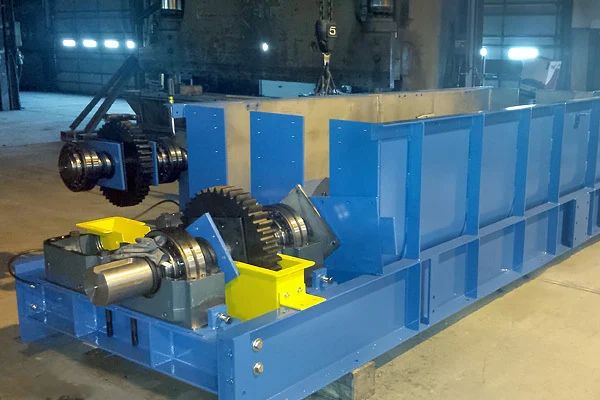What Is A Pug Mill Mixer?
What is a Pug Mill Mixer?
A pug mill mixer is a type of industrial mixing equipment used to blend and homogenize materials. The name “pug mill” comes from the word “pug”, which refers to clay that has a thick, doughy consistency. Pug mill mixers are commonly used to mix and homogenize materials like clay, ceramics, concrete, mortars, stucco, and asphalt.
The main function of a pug mill mixer is to continuously mix, blend, and homogenize wet and dry materials into a uniform mixture. This is achieved through dual shafts with paddles or blades that rotate in opposite directions, cutting and folding the materials together repeatedly as they are moved through the mixer.
Pug mill mixers are commonly used in construction industries. Some of the most common applications include:
- Mixing concrete, mortar, stucco, and grout mixtures for construction projects
- Blending asphalt and aggregates to make asphalt paving mixtures
- Mixing clay, minerals, and water to produce clay-based products
- Homogenizing soil, compost, fertilizers, and other agricultural materials
Overall, a pug mill mixer is an important industrial mixing tool used to blend and agitate a wide variety of materials into uniform mixtures for manufacturing, construction, and agricultural applications.
History of the Pug Mill Mixer
The pug mill mixer dates back to the early 1800s and originated as a device used in pottery making. At the time, potters would manually wedge and knead clay to prepare it for throwing on the pottery wheel. This was an arduous and labor-intensive process.
To improve efficiency, potters began experimenting with machinery that could replicate the wedging and kneading action. One of the earliest mechanical pug mills was developed in 1837 by Dwight and Lamberton of Bennington, Vermont, as noted by the Bennington Museum (Peter Pugger). This machine consisted of a horizontal shaft with fixed blades which would cut and fold the clay.
While early pug mills significantly reduced manual labor, the clay still needed to be fed into the machine in small batches. In 1889, Alfred Henry Leeson patented an improved pug mill design that allowed for continuous processing and mechanized clay extrusion (Wikipedia). Leeson’s pug mill had a rectangular hopper that stored and fed clay into the milling chamber.
Modern pug mills are highly engineered for efficient, high-volume production. They utilize advanced cutting blades, variable speed drives, and vacuum de-airing to produce smooth, homogeneous clay ready for molding and shaping.
How a Pug Mill Mixer Works
A pugmill mixer consists of a U-shaped trough with two counter-rotating shafts fitted with paddles or blades inside. The main components and parts of a pugmill mixer include:
- Trough – The large U-shaped tub that holds the materials to be mixed.
- Shafts – There are typically two parallel shafts running the length of the trough.
- Paddles/blades – These are affixed onto the shafts and do the actual mixing when the shafts rotate.
- Drive mechanism – This rotates the shafts and paddles to mix the contents.
- Cover – Covers the open top of the trough.
The mixing process in a pugmill mixer happens in the following steps:
- Materials are loaded into one end of the stationary trough.
- The shafts start rotating the paddles inside the trough.
- As materials move through the trough, the counter-rotating paddles continuously cut, smear, and blend them together into a homogeneous mixture.
- The intense mixing action binds fine and coarse particles into a uniform blend.
- The fully mixed material exits the discharge end of the trough.
The paddles fold the ingredients over as they move through the mixer, providing efficient end-to-end blending in a short time. Adjusting paddle speed and angle allows customizing the mixing intensity as per the material.https://feeco.com/how-does-a-pugmill-mixer-work/
Types of Pug Mill Mixers

Pug mill mixers come in several different types and designs based on their orientation and method of operation. The main types include:
Horizontal vs. Vertical
Horizontal pug mills have a horizontal shaft and cylindrical mixing chamber, while vertical pug mills have a vertical shaft and a U-shaped trough. Horizontal pug mills take up more floor space but can handle higher volumes. Vertical pug mills have a smaller footprint and lower capacity.[1]
Single vs. Double Pug Mill
Single pug mills contain one shaft and set of mixing paddles, while double pug mills contain two shafts and paddle sets. Double pug mills provide more intense mixing and kneading action. However, single pug mills are simpler and more affordable.[2]
Batch vs. Continuous
Batch pug mills mix material in timed batches, with a discharge gate to empty the batch. Continuous pug mills operate non-stop, constantly feeding in material and discharging it. Batch pug mills provide more control, while continuous mills have higher throughput.[3]
Selecting the right pug mill type depends on mixing needs, batch size, space constraints, and production volume. Manufacturers offer many configurations to suit different requirements.
[1] https://www.mclanahan.com/products/pugmill-mixers
[2] https://www.baileypottery.com/hand-building-clay-equipment/store-pugmills-and-mixers-by-type/store-pugmills-and-mixers-by-type-mixer-pugmills.html
[3] https://www.sheffield-pottery.com/Mixers-and-Pugmills-s/3.htm
Pug Mill Mixer Designs
Pug mill mixers come in a variety of standard designs as well as offer customization options to fit specific mixing needs.
Some common standard designs include:
- Single shaft paddle mixer – This basic design uses paddles on a single rotating shaft to mix material. It is an economical and simple option for lightweight mixing (https://feeco.com/pugmill-mixer-design-customization/).
- Double shaft paddle mixer – Two parallel shafts with mixing paddles provide additional mixing action over a single shaft design (https://www.mclanahan.com/products/pugmill-mixers).
- Ribbon blender – Helical ribbons are affixed to shaft(s) in a tub design. The ribbons fold and shear material as they rotate (https://feeco.com/pugmill-mixer-design-customization/).
Pug mill mixers can also be customized to meet specific requirements including:
- Motor power and torque
- Number and configuration of shafts/paddles
- Mixing chamber size and materials
- Discharge configurations
- Automation features
Experienced manufacturers work closely with clients to optimize the pug mill design for their particular mixing needs (https://www.mclanahan.com/products/pugmill-mixers).
Pug Mill Mixer Applications
Pug mill mixers are versatile devices with many applications across a range of industries. Some of the most common uses of pug mill mixers include:
Concrete Mixing: Pug mill mixers are commonly used to mix the ingredients for concrete production. The mixing action efficiently blends together cement, sand, gravel, water and any concrete additives. Pug mills provide consistent, thorough mixing to achieve a homogeneous concrete mixture.
Asphalt Mixing: Similar to concrete, pug mill mixers are also utilized in asphalt plants to combine and coat aggregates with liquid asphalt cement. The mixing action coats the aggregate material evenly to produce quality asphalt for paving projects.
Ceramics/Pottery: In the ceramics industry, pug mill mixers are used to homogenize and de-air clay mixtures to prepare them for molding and extrusion. The kneading action thoroughly mixes components and removes air pockets, resulting in smooth, workable ceramic clay.
Animal Feed: Pug mill mixers enable uniform blending of grains, molasses, vitamins and other ingredients in animal feed production. The efficient mixing produces consistent, high quality feed.
Fertilizer: Pug mills allow for custom fertilizer blending by mixing various dry and liquid ingredients. The intensive mixing action results in a homogeneous, granulated fertilizer product.
With their heavy-duty construction and efficient mixing action, pug mill mixers lend themselves to diverse mixing, blending and homogenizing applications across many industries.
Advantages of Pug Mill Mixers
Pug mill mixers offer several key advantages that make them a popular choice for industrial mixing applications:
Efficient Mixing: Pug mills provide thorough, uniform mixing through their dual shaft and pitched paddle design. The kneading and folding action ensures consistent blending of materials [1]. This makes them well-suited for mixtures that need homogeneous mixing.
Versatility: Pug mills can mix a wide range of materials including powders, liquids, granules, pastes, and slurries. Their heavy-duty construction allows them to handle abrasive and high viscosity mixes. They are used across many industries like construction, chemical, agriculture, etc [2].
Low Maintenance: Pug mills have a simple, rugged design with few moving parts. This minimizes maintenance requirements and downtime. The trough is easily accessible for inspection and cleaning [3].
Disadvantages of Pug Mill Mixers
While pug mill mixers offer many benefits, they also have some drawbacks to consider:
Can be loud – The intense mixing action and large motors in pug mill mixers can generate significant noise during operation. This is especially true for models without proper sound insulation or noise reduction features (Pugmill Mixer Troubleshooting Tips). Facilities may need to take steps to dampen noise or provide hearing protection for workers near pug mills.
Limited batch size – Pug mills are generally designed for specific batch sizes based on the mixer capacity and efficiency. Trying to under or overload a pug mill can lead to performance issues. Manufacturers offer pug mills in a wide range of sizes, but each unit will have limits in terms of batch size (Pugmills and Clay Mixers: Six Key Considerations to Make).
Prone to wear and tear – The intensive mixing in a pug mill subjects parts like paddles and liners to significant abrasion and stress over time. Facilities need to monitor condition and plan for regular maintenance and replacement of worn components. Proper materials selection and design is key to maximizing part life.
Pug Mill Mixer Maintenance
Proper maintenance is crucial for keeping a pug mill mixer running efficiently and preventing unplanned downtime. Some key maintenance considerations for pug mill mixers include:
Common wear parts that may need periodic replacement include the mixer paddles, arms, shaft liners, and tips. As these components wear down from constant contact and impact with the processed material, they can lead to performance declines if not replaced (For more tips see: https://feeco.com/nine-best-practices-for-pugmill-mixer-operations/).
Lubrication of all moving parts should be performed regularly according to manufacturer specifications. This includes lubricating the paddle shaft bearings, gear reducers, pinion gears, and drive chains. Proper lubrication prevents excessive wear and seizure of components.
Frequent cleaning keeps the interior free of material buildup. Accumulated materials can lead to imbalances and extra strain on mixer parts. Pressure washing or mechanical scraping can remove stubborn buildup.
Inspecting for signs of wear, testing for proper alignment, and monitoring noise/vibration levels can also help catch issues before they lead to equipment failure. Following preventive maintenance schedules and procedures recommended by the manufacturer helps maximize longevity.
Notable Pug Mill Mixer Manufacturers
Some of the top companies manufacturing pug mill mixers include:
McLanahan – Based in Hollidaysburg, Pennsylvania, McLanahan has been designing and manufacturing pug mill mixers since the 1950s. They offer both single and dual shaft pug mills for a variety of industries. McLanahan is known for innovations like their patented Quick Change Paddles to make changing paddles faster and safer.
Scott Equipment – With headquarters in New Prague, Minnesota, Scott Equipment has over 60 years of experience building pug mill mixers. They provide customized pug mill solutions and are a leading manufacturer of pug mills in North America.
Eirich – Located in Hardheim, Germany, Eirich has been producing industrial mixing technology since 1863. They provide high-quality pug mills worldwide for the construction, ceramic, foundry, and other industries. Eirich is known for their robust and efficient pug mill designs.
Munson Machinery – Based in Utica, New York, Munson has specialized in pug mill mixers since the 1950s. They offer a wide selection of pug mill models for bulk solids blending and are a popular provider of pug mills for the chemical, mineral, and food industries.

